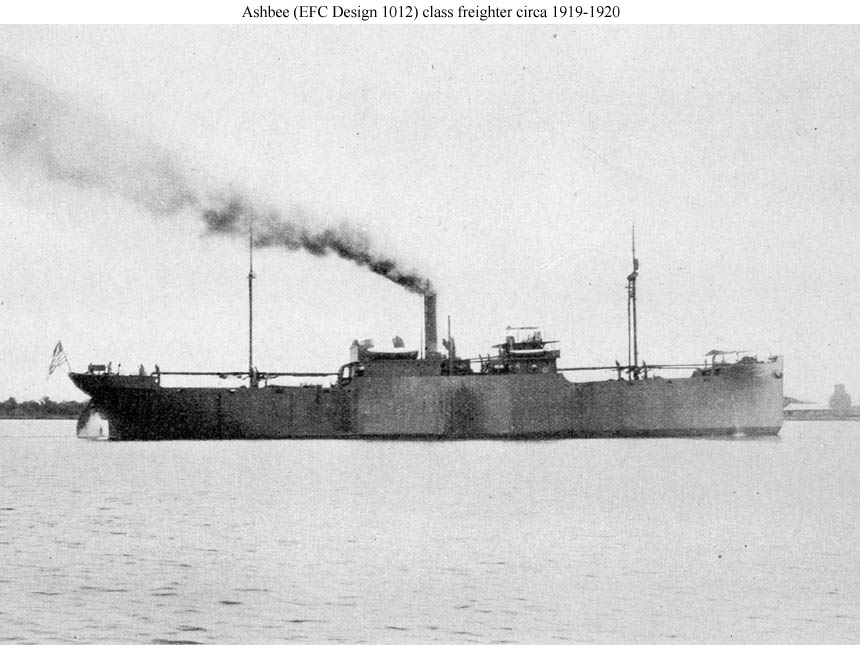EFC Design 1012 (Munrio type): Notes & Illustrations

Click here for larger and more complete plans from a 1925 EFC sales catalog: Sheet 1, Sheet 2
Click on the photographs below to prompt larger views of the same images.
|
Notes: On 18 April 1917 the Merrill-Stevens Shipbuilding Corp., using a large loan from the EFC that like other such loans may never have been repaid, began work on a new South Side Shipyard southeast across the river from its main yard in Jacksonville, Fla. The new yard initially consisted of one basin with four side launch ways plus about ten buildings including a concrete water tower. On 29 April 1917 the firm was awarded EFC Contract No. 1 for four Design 1009 composite cargo ships (wood planking on steel frames, yard nos. 99-102 and EFC hulls 1-4), and on 1 May 1917 the firm was awarded EFC Contract No. 2 for construction of four Design 1012 6000 ton steel cargo ships patterned on Maryland Steel's Munrio (yard nos. 103-106 and EFC hulls 13-16). The yard added a 6500 ton steel ship (yard no. 107) on its own account. The new South Side yard laid down the four composite hulls in its first basin in September-November 1917 and the last two of these were launched in August 1918. A contract of 29 October 1917 for six fabricated steel vessels of 9000 dwt (Design 1025) funded the construction at the South Side yard of a second basin alongside the first one with three more side launch ways. This second facility may be the one that was reported as opening on 17 May 1918. Construction dates of the composite and steel ships overlap, making it difficult to tell where the steel ships were built, but a captioned photo shows the first of them, Ashbee, being floated out of the original four launch way basin with ships under construction on the three other launch ways. The second basin was fully excavated but Jacksonville (yard no. 107) or possibly Chickamauga (yard no. 106) may have been the only ship built there. The six larger Design 1025 ships for which the second basin had been dug were cancelled on 15 July 1919 and the five smaller all-steel versions of Design 1009 (Design 1073) were suspended on 5 November 1919 and cancelled on 2 May 1919. Total output of the yard was four Design 1009 composite ships and five Design 1012 steel ships including one requisitioned. Requisitioned Sister: Yard no. 107, which had been ordered on the yard's account after receipt of the EFC order for four ships, was requisitioned on 3 August 1917 along with all other steel ships over 2500 tons then under construction or on order in American yards and was finally laid down in August 1918 as a fifth Design 1012 ship, Jacksonville. Specifications: Design 1012 (S.S. Ashbee, EFC Hull 13): Steel Cargo. Deadweight tons: 6000 designed, 5740 actual. Dimensions: 346.5' length oa, 334.5' pp x 48' beam mld. x 27.5' depth mld., 22.5' draft loaded. Propulsion: 1 screw, 1 Fletcher geared turbine, 2 Scotch boilers, 2000 SHP, 10.5 kts. Configuration: 3-island, 2 decks, 3 holds, 5 hatches. |

| An Ashbee (Design 1012) class freighter probably photogaphed around the time of her completion in 1919-1920. This photograph was used in a 1925 EFC sales catalog to represent this class. (NHHC: S-528-A) (Click photo to enlarge) |








